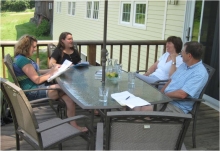You are here
It's the Network: Decision-Making by Forest Landowners

A recent study led by Harvard Forest Policy Analyst David Kittredge reveals surprising trends in how private landowners--whose small holdings comprise the majority of forests in the eastern U.S.--make decisions about their land.
The study shows that most landowners have an informal network of 7-10 people with whom they discuss general issues about their land. For major decisions, such as whether to harvest timber or permanently conserve land, they consult a much smaller group. These smaller, influential networks of 1-2 people most often include peer landowners, professionals, or other community members--not family members or neighbors, with whom they have stronger ties.
The research team suggests that resource professionals and organizations can use this knowledge to enhance informal networks and promote information-sharing among community peers and locals. Sound information-sharing is crucial to supporting regional ecosystem functions over the long term. Landowner decisions on each parcel of land influence clean water, wildlife habitat, outdoor recreation, and other regional factors well beyond the parcel's borders.
Co-authors on the study, published in the Northern Journal of Applied Forestry, include two former Summer Research Program students--Emma Snellings and Angelica Erazo--and former Bullard Fellow Mark Rickenbach. Landowners interviewed came from 19 contiguous towns in north Central Massachusetts.

